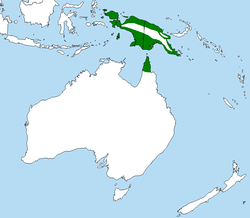Probosciger
| Palm cockatoo | |
|---|---|
 |
|
| At Melaka Zoo, Malaysia | |
| Scientific classification | |
| Kingdom: | Animalia |
| Phylum: | Chordata |
| Class: | Aves |
| Order: | Psittaciformes |
| Superfamily: | Cacatuoidea |
| Family: | Cacatuidae |
| Subfamily: | Cacatuinae |
| Tribe: | Microglossini |
| Genus: |
Probosciger Kuhl, 1820 |
| Species: | P. aterrimus |
| Binomial name | |
|
Probosciger aterrimus (Gmelin, 1788) |
|
| Subspecies | |
|
P. a. aterrimus |
|
 |
|
| Australian palm cockatoo range (in green) | |
P. a. aterrimus
P. a. goliath
P. a. macgillivrayi
P. a. stenolophus
The palm cockatoo (Probosciger aterrimus), also known as the goliath cockatoo or great black cockatoo, is a large smoky-grey or black parrot of the cockatoo family native to New Guinea, Aru Islands and Cape York Peninsula. It has a very large black beak and prominent red cheek patches.
The palm cockatoo was originally described by German naturalist Gmelin in 1788. Its specific name, Probosciger aterrimus, is from Latin proboscis, long thin nose + -ger, carry and Latin superlative adjective for ater, black, hence a "black [bird] with a long thin nose (beak)".
The only member of the monotypic genus, Probosciger, the palm cockatoo is a member of the white cockatoo subfamily Cacatuinae. Earlier limited genetic studies found it to be the earliest offshoot from the ancestors of what have become the cockatoo family.
There are three poorly differentiated subspecies, and one distinctive subspecies: Cape York cockatoo (P. a. aterrimus[Gmelin 1788]), the larger goliath cockatoo (P. a. goliath[Kuhl 1820]), Northern palm cockatoo (P. a. stenolophus[van Ort 1911]) similar to goliath but crest feathers much narrower, and P. a. macgillivrayi[Mathews 1927] intermediate in size.
The species was named the "Goliath Aratoo" in Wood's Natural History (1862). It is also sometimes given the misnomer "black macaw" in aviculture - the macaws are unrelated New World parrots. Confusingly, this name was also used by early naturalists and Brazilian natives to refer to the dark blue hyacinth macaw.
The palm cockatoo is 55 to 60 cm (22 to 24 in) in length and weighs 910–1,200 g (2.01–2.65 lb). It may be the largest cockatoo species and largest parrot in Australia, although large races of yellow-tailed black cockatoos and sulphur-crested cockatoos broadly overlap in size. It is a distinctive bird with a large crest and has one of the largest bills of any parrot (only the hyacinth macaw's is larger). This powerful bill enables palm cockatoos not only to eat very hard nuts and seeds, but it also enables males to break off thick (~1") sticks from live trees to use for a drumming display (Wood 1984). The male has a larger beak than the female. The bill is unusual as the lower and upper mandibles do not meet for much of its length, allowing the tongue to hold a nut against the top mandible while the lower mandible works to open it. The palm cockatoo also has a distinctive red cheek patch that changes colour when the bird is alarmed or excited.
...
Wikipedia

